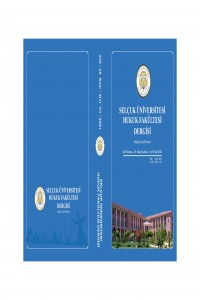Abstract
İspat hukuku açısından görsel veya işitsel yolla edinilen bilgilerin mahkemeye aktarılması, en önemli takdiri delillerden olan tanık beyanını oluşturmaktadır. İdari yargılama hukukunda tanık delilinin uygulanması gerektiğine ilişkin doğrudan veya atıf niteliğinde bir düzenleme bulunmadığı gibi idari yargı makamları tarafından da tanık delili uygulamada kabul edilmemektedir.
Tanık delilinin idari yargıda kabul edilmesi adil yargılanma hakkının etkin kullanılması ve hukuk devleti ilkesinin güçlenmesi açısından önem arz etmek-tedir. İspat hukuku yönünden değerli bir delil türü olan ve idari yargılama hukukunda tartışmalı bir konu olan tanık delilini, doktrindeki tespit ve değer-lendirmeler ile yargı makamlarının içtihatları kapsamında yorumlayıp tanık delilinin mevcut aşamadaki niteliği ve delil değeri hakkında tarafımızca bazı değerlendirmeler yapılmıştır.
Keywords
References
- AKINCI, Müslüm, Adil Yargılanma Hakkı, Turhan Kitabevi, Ankara, 2008.
- AKYILMAZ, Bahtiyar/SEZGİNER, Murat/KAYA, Cemil, Türk İdari Yargılama Hukuku, Savaş Yayınevi, Ankara, 2018.
- ARDIÇOĞLU, Artuk, “İdari Yargıda Tanık”, Yaklaşım Dergisi, Ankara, S. 215, Kasım 2010, ss. 297-303.
- BİLGİN, Hüseyin, İdari Davalar ve Çözüm Yolları, Seçkin Yayınları, Ankara, 2018.
- CEYLAN, Mahmut, İdari Yargıya Hakim Olan İlkeler, On İki Levha Yayınları, İstanbul, 2017.
- ÇAĞLAYAN, Ramazan, İdari Yargılama Hukuku, 10. Baskı, Seçkin Yayınları, Ankara, 2018.
- GÖZLER, Kemal/KAPLAN, Gürsel, İdare Hukukuna Giriş, 14. Baskı, Ekin Yayınevi, Bursa, 2011.
- GÖZÜBÜYÜK, A. Şeref, Yönetsel Yargı, 28. Baskı, Turhan Kitabevi, Ankara, 2009.
- GÜNDAY, Metin, İdare Hukuku, 10. Baskı, İmaj Yayınevi, Ankara, 2011.
- HONDU, Selçuk, "İdari Yargılama Usulünde ‘Duruşma’ Yapılması ve Uygulamadaki Durum", Danıştay Dergisi, S. 89, 1995, ss. 3-16.
Abstract
From the point of view of the law of proof, the transfer of information obtained by visual or auditory means to the court constitutes the witness statement, which is the most important assessment of the evidence. The administrative judiciary does not have a direct or reference regulation that the evidence of the witness should be applied, nor is it accepted by the administrative judicial authorities in the application of witness evidence.
Accepting witness evidence in the administrative judiciary is important for the effective exercise of the right to a fair trial and for strengthening the principle of the rule of law. We have reviewed the evidence of the witness, the evidence in the doctrine, the assessments and the jurisdictions of the judiciary, which is a valuable type of evidence in terms of evidence law and a controversial issue in the administrative jurisdiction law and have made some assessments about the nature and value of evidence at the current stage.
References
- AKINCI, Müslüm, Adil Yargılanma Hakkı, Turhan Kitabevi, Ankara, 2008.
- AKYILMAZ, Bahtiyar/SEZGİNER, Murat/KAYA, Cemil, Türk İdari Yargılama Hukuku, Savaş Yayınevi, Ankara, 2018.
- ARDIÇOĞLU, Artuk, “İdari Yargıda Tanık”, Yaklaşım Dergisi, Ankara, S. 215, Kasım 2010, ss. 297-303.
- BİLGİN, Hüseyin, İdari Davalar ve Çözüm Yolları, Seçkin Yayınları, Ankara, 2018.
- CEYLAN, Mahmut, İdari Yargıya Hakim Olan İlkeler, On İki Levha Yayınları, İstanbul, 2017.
- ÇAĞLAYAN, Ramazan, İdari Yargılama Hukuku, 10. Baskı, Seçkin Yayınları, Ankara, 2018.
- GÖZLER, Kemal/KAPLAN, Gürsel, İdare Hukukuna Giriş, 14. Baskı, Ekin Yayınevi, Bursa, 2011.
- GÖZÜBÜYÜK, A. Şeref, Yönetsel Yargı, 28. Baskı, Turhan Kitabevi, Ankara, 2009.
- GÜNDAY, Metin, İdare Hukuku, 10. Baskı, İmaj Yayınevi, Ankara, 2011.
- HONDU, Selçuk, "İdari Yargılama Usulünde ‘Duruşma’ Yapılması ve Uygulamadaki Durum", Danıştay Dergisi, S. 89, 1995, ss. 3-16.
Details
| Primary Language | Turkish |
|---|---|
| Subjects | Law in Context |
| Journal Section | RESEARCH ARTICLES |
| Authors | |
| Publication Date | September 15, 2021 |
| Acceptance Date | September 15, 2021 |
| Published in Issue | Year 2021 Volume: 29 Issue: 3 |


